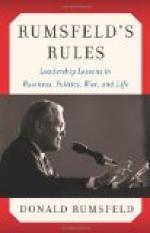All these aspects of his problem a General thinks out before he starts; he does not make his attempt unless and until he sees his way to meet the various difficulties, both those inherent in the nature of the operation and those that arise from the local conditions and from the character of the particular enemy. The difficulties are therefore not reasons why General Buller should not succeed, but their consideration may help to show why with the best previous deliberation and with the bravest of troops he may perhaps not be able to break the Boer resistance.
There is one feature of his task that is perhaps not fully appreciated by the public. In order to relieve Ladysmith he must thoroughly defeat and drive away the Boer army—must, so to speak break its back. For, supposing he could clear a road to Ladysmith and march there, leaving the Boer army in position on one or both sides of his road, his position on reaching the place would be that he would have to fight his way back again, and that unless he could then defeat the Boers his Army would be lost, for it would be cut off from its supplies. The relief of Ladysmith and the complete defeat of the Boer army are therefore synonymous terms. There is, however, a sense in which a partial defeat of the Boers would be of use. If the Boer army, though not driven off, were yet fully absorbed in its struggle with Sir Redvers Bullet and had drawn to its assistance some portion of the force investing Ladysmith, it might be possible for Sir George White to make a sortie and to break through the investing lines. To that case, however, the term “the relief of Ladysmith” could hardly be correctly applied.
How far Sir George White can co-operate with Sir Redvers Buller depends partly upon the mobility of his force. His horses after three months in Ladysmith can hardly be in much condition, even supposing that they have not already begun to be used as food for the troops. Supposing there are horses enough for the field guns, and that the naval guns and mountain guns were destroyed at the last moment before the sortie. The men and the field artillery would then have to make a night attack, followed by a march of about seven miles in trying conditions, and by a second attack in which they would join hands with Sir Redvers Buller. This does not imply exertions impossible to troops like Sir George White’s, and such a move perhaps offers the best way out of the difficulties of the situation. If in that case Sir George White made for the north side of Dorn Kop a part of the Boer army would probably be destroyed, and the loss which the British force would have suffered would thus to some extent be made up for. It is presumed that Sir Redvers Buller and Sir George White, who are able to communicate with one another, have a cipher which enables them to inform each other without informing the enemy.




